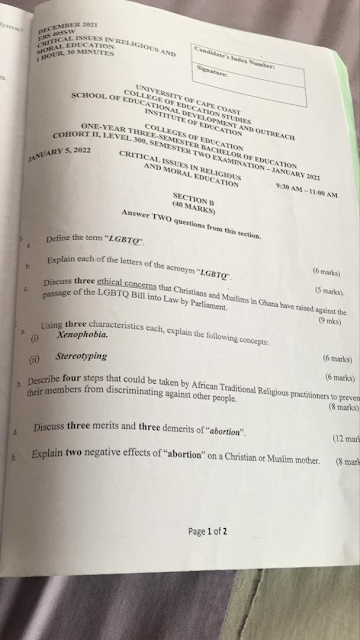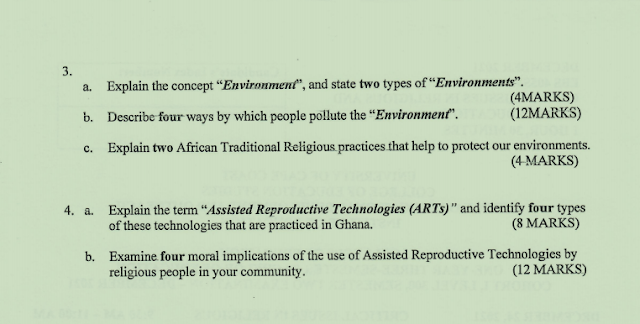Archive for October 2023
MOST LIKELY QUESTIONS: CRITICAL ISSUES IN RME
MOST LIKELY QUESTIONS: CRITICAL ISSUES IN RME
LIKELY EXAMINABLE
CLICK ON THE IMAGES TO ENSURE CLARITY
FIRST SET
LIKELY END OF SEM: INFO MANAGEMENT SYSTEM
LIKELY END OF SEM: INFO MANGEMENT SYSTEM
MARKING SCHEME
INFORMATION SYSTEM MANAGEMENT
Answer ALL the questions.
[20 MARKS]
For items 1 to 10, write the appropriate responses in the spaces provided.
1. Interrelated component (subsystems) that work towards the achievement of a set goal is called
System.
2. A set of interrelated components that collect (or retrieve), process, store, and distribute information to support decision making and control in an organization is known as
information System
3. A collection of raw facts such as numbers, words, measurements, observations or just descriptions of things is known as Data
4. Conducting business via the Internet is known as e-business
5. Acceptable network etiquette is termed as Netiquette
6. Electronic commerce that is conducted between businesses and individual consumers is referred to as Business-to-Consumer
7. Problems associated with the file-based system are resolved by database/DBMS
8. One component of database environment is Hardware/Software/Database/Liveware/ procedure/people/etc.
9. A shared collection of logically related data, and their descriptions designed to meet the information needs of an organization is called Database
10. A system that interacts freely with its environment, taking inputs and influences from the environment and returning outputs and influences to the environment is called Open System
Items 11 to 20 are stems followed by four options lettered A to D. Read each item carefully and circle the letter of the correct or best option.
11. The person whose job is to maintain and provide authorization of access to database is called database ……………
A. administrator.
B. designer.
C. end-user.
D. manager.
12. Redundancy of data is associated with ……………
A. Data management system.
B. Database management system.
C. SQL command.
D. Traditional file-based system.
13. The study of physical relationship between people and their tools, such as the computer to avoid its harmful effect and also make the users more productive is known as ……………
A. ergonomics.
B. netiquette.
C. plagiarism.
D. privacy.
14. One of the following is not a core principle of computer security.
A. Authentication.
B. Availability.
C. Confidentiality.
D. Integrity.
15. One of the following is usually not a form of payment in e-business.
A. Digital Cash.
B. E-Cash.
C. Mobile Payment/Money.
D. Physical Cash.
16. One of the following is not an advantage associated with e-business.
A. Convenient.
B. Easiness.
C. Fast.
D. Risky.
17. A self-replicating malware is called ……………
A. spam.
B. trojan horse.
C. virus.
D. worm.
18. The exclusive control you have over a software you have developed is called ……………
A. copyright.
B. piracy.
C. plagiarism.
D. privacy.
19. If you copy a solution to an assignment from the Internet and present it as your own it is
referred to as ……………
A. copyright.
B. piracy.
C. plagiarism.
D. privacy.
20. The process of verifying your identity on a network or whilst using an ATM is called ………
A. authentication.
B. conformation.
C. passwording.
D. verification.
MOST LIKELY QUESTIONS: HISTORY AND DEVELOPMENT OF EDUCATION IN GHANA
MOST LIKELY QUESTIONS: HISTORY AND DEVELOPMENT OF EDUCATION IN GHANA
AREAS OF CONCENTRATION
There will be 4 essay questions from which the candidates will be required to answer 2. The broad areas include: Castle school education; 2008 Education Act - bodies established; Guggisberg; Missionary education.
SECTION B
CLICK ON THE IMAGE TO ENSURE CLARITY
LIKELY OBJECTIVIES
MID SEM MARKING SCHEME
JOIN OUR END OF SEM EXCLUSIVE WHATSAPP GROUP HERE
HISTORY OF AND DEVELOPMENT OF EDUCATION
UNIVERSITY OF CAPE COAST
INSTITUTE OF EDUCATION
REGULAR 4-YEAR BASIC EDUCATION DEGREE PROGRAMME
MID-SEMESTER EXAMINATION, 2022
EBS 433: HISTORY AND DEVELOPMENT OF EDUCATION IN GHANA
MARKING SCHEME
1. All the following were reasons for colonial government delay in the participation in education in the Gold Coast except…………………….
A. rivalry among the European nations hence the government’s stay uncertain.
B. that the first world war negatively affected government finances.
C. the colonial government back home wasn’t providing education for her citizens.
D. the colonial government’s lack of commitment.
2. How was education supposed to be funded by the passing of the first education ordinance in the Gold Coast? Through …………
A. Ghana Education Trust (GET)
B. Ghana Education Trust Fund (GETFund)
C. Government scholarships
D. Poll tax
3. Which of the following was not a provision of the 1852 education ordinance?
A. Grant-in -aid for mission schools
B. Inclusion of technical education in the curriculum
C. Promoting girls’ education
D. Training of the teachers by Mr and Mrs Vinall
4. As one of the causes of the failure of the 1852 Education Ordinance was attributed to which of these wars?
A. Sargranti War
B. The battle of Feyiase
C. The battle of Nsamankow
D. Yaa Asantewaa War
5. The Rev. Melcafe Sunter was appointed Inspector of Schools as a result of a provision of which education ordinance?
A. 1852
B. 1882
C. 1887
D. 1925
6. Prior to being appointed Inspector of School, what position did the Rev. Sunter hold?
A. Director general of the G.E.S
B. Governor of the Christianborg castle
C. Principal of Achimota School
D. Principal of Fourah-Bay College
7. Which of the following statements is true as far as Rev. M. Sunter was concerned?
A. He believed mission school teachers should focus more on preaching than the teaching work.
B. He considered the ordinance as very workable.
C. His attitude towards implementation of the ordinance was basically negative.
D. The use of vernacular in teaching was greatly endorsed by him.
8. Which of the following was not one of the conditions under which mission schools could receive assistance?
A. At least half of the staff should be professionally trained
B. Having average enrolment not less than 20
C. Pupils to be admitted irrespective of their religion or tribe
D. The schools should open their doors for inspection
9. Which of the following statement is true about Phelps Stokes?
A. She set up a foundation to support the education of Blacks.
B. She supported and promoted girl-child education.
C. She was Chairman of Phelps Stokes Commission to Africa.
D. She was one of American pioneer educators
10. Who was the Ghanaian member of the Phelps Stokes’ Commission to Africa?
A. Dr. Caseley Hayford
B. Dr. Jesse Jones
C. Dr. Kwegir Aggrey
D. Dr. Mensah Sarbah
11. Which of the following was true about the payment by results?
A. School heads were encouraged to introduce just few courses.
B. It created enmity between teachers and inspectors.
C. Vocational training was given a great boost.
D. It promoted practical and effective learning.
12. Guggisberg’s 3rd principle of education relates to …………….
A. ensure primary education was thorough from bottom to the top.
B. the need for co-education at certain stages of education.
C. the promotion of equal educational opportunities for boys and girls.
D. the provision of a university
13. One of Guggisberg’s principles of education was that, primary education should be thorough from bottom to the top. This suggests that………………..
A. children must learn throughout the period of schooling.
B. mission and government schools should teach the same things throughout.
C. quality education should be maintained right from the beginning to the end.
D. schools should be appraised to see those which would be first and last.
14. What education policy or intervention marked the first attempt to introduce free education in Ghana?
A. Accelerated Development Plan of Education
B. Free Compulsory Universal Basic Education
C. The 1961 Education Act
D. Universal Basic Education Policy
For items 15 to 18, indicate whether the statement is True or False.
15. One major factor that accounted for the failure of the 1852 education ordinance was payment by results
A. False
B. True
16. Guggisberg was highly in support of free education
A. False
B. True
17. One adverse effect of the Accelerated Development Plan of Education was that it led to the dilution of the quality of teachers
A. False
B. True
18. The Phelps Stokes’ Commission to Africa recommended that African education should be tailored along that of Europeans in order to meet standards.
A. False
B. True
For items 19 to 22, supply the right answers.
19. Why was the Education Act of 1961 passed when the Accelerated Development Plan of Education was already in place?
It was to give the ADP the necessary legal backing
……………………………………………………………………………….
20. What was Guggisberg’s 16th principle of education?
Provision of trade schools with technical and literacy education
…………………………………………………………………………………
21. Mr. J. D. Oman, who made a visit to two educational institutions in the US as a follow up to the Phelps Stokes Commission to Africa learned two main things namely;
1) The need to adapt education to local needs
2) The need for co-educational institutions
22. By the 1961 Education Act, what responsibilities were given to the local education authorities?
Build, equip and maintain all primary and middle schools in the area
Marks Distribution
1 – 14 1 mark each = 14 marks
15 – 18 ½ mark each =2 marks
19 – 22 1 mark each = 4 marks
Total = 20 marks




















.jpg)

















